Urban Traffic Noise Mapping Using Building Simplification in the Panyu District of Guangzhou City, China
Abstract
:1. Introduction
1.1. First Method
1.2. Second Method
1.3. Third Method
- Combine the methods of field measurement and numerical modeling (CadnaA software) to produce a traffic noise map of Panyu District that includes road and railway traffic with all vegetation areas and buildings of different heights.
- Investigate the traffic noise compliance rate in various acoustic environment functional regions, given that noise limits differ considerably between night and day in some areas.
- Identify the areas with serious traffic noise pollution.
2. Methods
- Obtain road, building and railway information from literature databases. This information is used to produce an outline map of Panyu District.
- Classify all roads based on China’s national standard and then select field measurement points on different road types.
- Conduct field measurement on the selected measurement points in order to measure traffic flow, vehicle speed, vehicle type and traffic noise.
- Traffic flow, vehicle speed and vehicle type are the inputs for CadnaA software to construct noise map.
- The map’s noise levels that computed by CadnaA software are compared with the measured traffic noise levels in order to validate the noise map.
- Various studies can be performed based on the validated noise map.
2.1. Numerical Methods
2.1.1. Modeling Information
2.1.2. Outline Map
2.1.3. Building Simplification
2.1.4. Building Height Simplification
2.1.5. Receivers’ Height
2.1.6. Grid Independency Study
2.1.7. Road Type Classification
2.1.8. Railway Information
2.2. Experimental Methods
2.2.1. Measurement Point
2.2.2. Field Measurement
Road Traffic Noise Measurement
Vehicle Speed Measurement
Traffic Flow and Vehicle Type Measurements
Overpass Height Measurement
3. Results and Discussion
3.1. Noise Map of Panyu District
3.2. Noise Quality Levels in Panyu District
3.3. Noise Level Compliance Map in Panyu District
3.4. Comparison between Measurement and Simulation Results
3.5. Road Traffic Flow Analysis
4. Conclusions
Author Contributions
Funding
Institutional Review Board Statement
Informed Consent Statement
Data Availability Statement
Conflicts of Interest
Appendix A
| Number | Number of Floor | Building Height (m) | Number | Number of Floor | Building Height (m) |
|---|---|---|---|---|---|
| 1 | 7 | 21 | 28 | 5 | 15 |
| 2 | 8 | 24 | 29 | 5 | 15 |
| 3 | 7 | 21 | 30 | 12 | 36 |
| 4 | 5 | 15 | 31 | 6 | 18 |
| 5 | 3 | 9 | 32 | 7 | 21 |
| 6 | 27 | 81 | 33 | 4 | 12 |
| 7 | 5 | 15 | 34 | 12 | 36 |
| 8 | 3 | 9 | 35 | 5 | 15 |
| 9 | 6 | 18 | 36 | 6 | 18 |
| 10 | 21 | 63 | 37 | 12 | 36 |
| 11 | 5 | 15 | 38 | 6 | 18 |
| 12 | 8 | 24 | 39 | 18 | 54 |
| 13 | 4 | 12 | 40 | 5 | 15 |
| 14 | 25 | 75 | 41 | 18 | 54 |
| 15 | 5 | 15 | 42 | 5 | 15 |
| 16 | 18 | 54 | 43 | 4 | 12 |
| 17 | 21 | 63 | 44 | 4 | 12 |
| 18 | 5 | 15 | 45 | 5 | 15 |
| 19 | 21 | 63 | 46 | 28 | 84 |
| 20 | 6 | 18 | 47 | 5 | 15 |
| 21 | 21 | 63 | 48 | 21 | 63 |
| 22 | 12 | 36 | 49 | 28 | 84 |
| 23 | 5 | 15 | 50 | 21 | 63 |
| 24 | 6 | 18 | 51 | 18 | 54 |
| 25 | 27 | 81 | 52 | 5 | 15 |
| 26 | 6 | 18 | 53 | 4 | 12 |
| 27 | 32 | 96 |
| Type | Speed Limit (km/h) | Traffic Capacity (pcu/h) |
|---|---|---|
| Expressway | 80∼120 | 1100∼2200 |
| Highway | 60∼100 | 1400∼2000 |
| Arterial road | 40∼60 | 1300∼1400 |
| Sub-arterial road | 30∼50 | 1300∼1350 |
| Access road | 20∼40 | 1100∼1300 |
| Type | Vehicle Mass (t) |
|---|---|
| Small car | <5 |
| Mid-size car | 3.5∼12 |
| Large car | >12 |
| Quality Level | Range (dBA) |
|---|---|
| Good | ≤50 |
| Quite good | 50.1–55.0 |
| Slightly polluted | 55.1–60.0 |
| Moderately polluted | 60.1–65.0 |
| Heavy polluted | >65 |

| Type | Measurement Point | M | M | S | S | E | E |
|---|---|---|---|---|---|---|---|
| Expressway | 29 | 71.1 | 71.2 | 72.2 | 72.0 | −1.1 | −0.8 |
| 37 | 65.7 | 65.3 | 68.5 | 68.7 | −2.8 | −3.4 | |
| 38 | 68.7 | 68.1 | 70.6 | 69.9 | −1.9 | −1.8 | |
| 51 | 70.0 | 70.7 | 72.1 | 73.3 | −2.1 | −2.6 | |
| Highway | 14 | 73.4 | 73.0 | 75.2 | 75.4 | −1.8 | −2.4 |
| 25 | 76.5 | 76.3 | 75.3 | 74.8 | 1.2 | 1.5 | |
| 50 | 75.6 | 75.5 | 75.9 | 75.7 | −0.3 | −0.2 | |
| Arterial road | 1 | 68.4 | 65.9 | 69.7 | 67.3 | −1.3 | −1.4 |
| 5 | 57.4 | 57.5 | 59.9 | 59.6 | −2.5 | −2.1 | |
| 11 | 71.7 | 70.3 | 72.5 | 71.4 | −0.8 | −1.1 | |
| 18 | 73.0 | 73.0 | 73.7 | 73.4 | −0.7 | −0.4 | |
| 19 | 71.5 | 71.0 | 71.9 | 71.8 | −0.4 | −0.8 | |
| 23 | 68.9 | 68.3 | 68.1 | 68.5 | 0.8 | −0.2 | |
| 32 | 66.4 | 62.0 | 67.3 | 63.6 | −0.9 | −1.6 | |
| 39 | 67.3 | 67.2 | 67.5 | 67.4 | −0.2 | −0.2 | |
| 45 | 68.7 | 69.0 | 68.3 | 69.6 | 0.4 | −0.6 | |
| 49 | 75.5 | 73.0 | 73.8 | 73.5 | 1.7 | −0.5 | |
| 52 | 63.7 | 63.5 | 64.9 | 64.7 | −1.2 | −1.2 | |
| 54 | 67.1 | 67.0 | 68.7 | 67.6 | −1.6 | −0.6 | |
| 56 | 70.7 | 70.2 | 71.1 | 70.6 | −0.4 | −0.4 | |
| 59 | 69.2 | 67.5 | 69.7 | 68.6 | −0.5 | −1.1 | |
| Sub-arterial road | 3 | 62.5 | 60.6 | 63.1 | 61.9 | −0.6 | −1.3 |
| 4 | 62.9 | 60.0 | 64.0 | 56.6 | −1.1 | 3.4 | |
| 8 | 66.2 | 66.3 | 68.5 | 68.8 | −2.3 | −2.5 | |
| 9 | 67.7 | 68.9 | 68.0 | 67.3 | −0.3 | 1.6 | |
| 12 | 73.2 | 74.2 | 74.3 | 74.4 | −1.1 | −0.2 | |
| 15 | 64.3 | 64.8 | 65.9 | 66.1 | −1.6 | −1.3 | |
| 16 | 66.7 | 62.6 | 67.1 | 66.2 | −0.4 | −3.6 | |
| 20 | 68.3 | 68.6 | 69.9 | 69.1 | −1.6 | −0.5 | |
| 21 | 67.7 | 67.8 | 68.8 | 69.1 | −1.1 | −1.3 | |
| 24 | 67.8 | 66.9 | 68.0 | 68.3 | −0.2 | −1.4 | |
| 27 | 67.8 | 68.4 | 68.4 | 69.1 | −0.6 | −0.7 | |
| 33 | 57.4 | 56.6 | 58.6 | 58.7 | −1.2 | −2.1 | |
| 34 | 56.0 | 55.7 | 58.7 | 58.3 | −2.7 | −2.6 | |
| 35 | 55.6 | 57.4 | 59.0 | 59.3 | −3.4 | −1.9 | |
| 42 | 64.8 | 65.2 | 64.6 | 66.1 | 0.2 | −0.9 | |
| 44 | 70.2 | 70.0 | 70.5 | 69.5 | −0.3 | 0.5 | |
| 46 | 60.7 | 63.4 | 62.5 | 61.6 | −1.8 | 1.8 | |
| 47 | 65.1 | 65.3 | 65.8 | 65.6 | −0.7 | −0.3 | |
| 53 | 61.4 | 62.3 | 61.6 | 62.7 | −0.2 | −0.4 | |
| 55 | 67.4 | 68.7 | 67.7 | 67.5 | −0.3 | 1.2 | |
| 60 | 63.0 | 61.9 | 63.9 | 62.1 | −0.9 | −0.2 | |
| 61 | 67.4 | 66.1 | 68.9 | 68.5 | −1.5 | −2.4 | |
| 64 | 61.1 | 58.2 | 60.4 | 60.2 | 0.7 | −2.0 | |
| Access road | 2 | 62.2 | 59.2 | 63.4 | 63.3 | −1.2 | −4.1 |
| 6 | 53.9 | 52.0 | 57.7 | 56.7 | −3.8 | −4.7 | |
| 7 | 61.4 | 64.7 | 61.7 | 62.2 | −0.3 | 2.5 | |
| 10 | 66.3 | 65.3 | 67.2 | 67.4 | −0.9 | −2.1 | |
| 13 | 60.3 | 64.5 | 63.9 | 62.7 | −3.6 | 1.8 | |
| 17 | 58.6 | 58.3 | 59.5 | 58.5 | −0.9 | −0.2 | |
| 22 | 64.4 | 64.7 | 65.2 | 65.0 | −0.8 | −0.3 | |
| 26 | 66.1 | 58.5 | 67.5 | 61.8 | −1.4 | −3.3 | |
| 28 | 59.1 | 57.0 | 57.3 | 57.7 | 1.8 | −0.7 | |
| 30 | 57.8 | 55.2 | 58.8 | 58.0 | −1.0 | −2.8 | |
| 31 | 65.4 | 67.1 | 66.7 | 67.0 | −1.3 | 0.1 | |
| 36 | 65.5 | 62.0 | 62.8 | 62.9 | 2.7 | −0.9 | |
| 40 | 59.0 | 63.7 | 59.9 | 60.3 | −0.9 | 3.4 | |
| 41 | 62.8 | 61.8 | 63.4 | 64.9 | −0.6 | −3.1 | |
| 43 | 68.2 | 67.2 | 68.5 | 68.7 | −0.3 | −1.5 | |
| 48 | 64.5 | 64.2 | 67.4 | 67.6 | −2.9 | −3.4 | |
| 57 | 63.3 | 62.4 | 63.1 | 63.5 | 0.2 | −1.1 | |
| 58 | 58.8 | 55.6 | 58.5 | 57.8 | 0.3 | −2.2 | |
| 62 | 59.1 | 57.3 | 62.3 | 58.9 | −3.2 | −1.6 | |
| 63 | 62.7 | 60.8 | 63.2 | 65.5 | −0.5 | −4.7 | |
| 65 | 63.3 | 62.8 | 66.0 | 64.4 | −2.7 | −1.6 |
References
- Assessment and Management of Environmental Noise; Technical Report Directive 2002/49/EC; The European Parliament and The Council of The European Union: Luxembourg, 2002.
- Banerjee, D.; Chakraborty, S.K.; Bhattacharyya, S.; Gangopadhyay, A. Appraisal and mapping the spatial-temporal distribution of urban road traffic noise. Int. J. Environ. Sci. Technol. 2009, 6, 325–335. [Google Scholar] [CrossRef] [Green Version]
- Hossam Eldien, H. Noise mapping in urban environments: Application at Suez city center. In Proceedings of the 2009 International Conference on Computers Industrial Engineering, Troyes, France, 6–9 July 2009; pp. 1722–1727. [Google Scholar] [CrossRef]
- Das, P.; Talukdar, S.; Ziaul, S.; Das, S.; Pal, S. Noise mapping and assessing vulnerability in meso level urban environment of Eastern India. Sustain. Cities Soc. 2019, 46, 101416. [Google Scholar] [CrossRef]
- de Noronha Castro Pinto, F.A.; Moreno Mardones, M.D. Noise mapping of densely populated neighborhoods-example of Copacabana, Rio de Janeiro-Brazil. Environ. Monit. Assess. 2009, 155, 309–318. [Google Scholar] [CrossRef] [PubMed]
- Zannin, P.H.T.; de Sant’Ana, D.Q. Noise mapping at different stages of a freeway redevelopment project—A case study in Brazil. Appl. Acoust. 2011, 72, 479–486. [Google Scholar] [CrossRef]
- Suarez, E.; Barros, J. Traffic noise mapping of the city of Santiago de Chile. Sci. Total. Environ. 2014, 466–467, 539–546. [Google Scholar] [CrossRef] [PubMed]
- Bastian-Monarca, N.A.; Suarez, E.; Arenas, J.P. Assessment of methods for simplified traffic noise mapping of small cities: Casework of the city of Valdivia, Chile. Sci. Total. Environ. 2016, 550, 439–448. [Google Scholar] [CrossRef] [PubMed]
- Lokhande, S.; Dhawale, S.; Pathak, S.; Gautam, R.; Jain, M.; Bodhe, G. Appraisal of Noise Level Dissemination Surrounding Mining and Industrial Areas of Keonjhar, Odisha: A Comprehensive Approach Using Noise Mapping. Arch. Acoust. 2017, 42, 423–432. [Google Scholar] [CrossRef] [Green Version]
- De Coensel, B.; Sun, K.; Wei, W.; Van Renterghem, T.; Sineau, M.; Ribeiro, C.; Can, A.; Aumond, P.; Lavandier, C.; Botteldooren, D. Dynamic noise mapping based on fixed and mobile sound measurements. In Proceedings of the 10th European Congress and Exposition on Noise Control Engineering (Euronoise 2015), Maastricht, The Netherlands, 31 May–3 June 2015; pp. 2339–2344. [Google Scholar]
- Wei, W.; Van Renterghem, T.; De Coensel, B.; Botteldooren, D. Dynamic noise mapping: A map-based interpolation between noise measurements with high temporal resolution. Appl. Acoust. 2016, 101, 127–140. [Google Scholar] [CrossRef] [Green Version]
- Benocci, R.; Bellucci, P.; Peruzzi, L.; Bisceglie, A.; Angelini, F.; Confalonieri, C.; Zambon, G. Dynamic Noise Mapping in the Suburban Area of Rome (Italy). Environments 2019, 6, 79. [Google Scholar] [CrossRef] [Green Version]
- Carli, R.; Dotoli, M.; Epicoco, N.; Angelico, B.; Vinciullo, A. Automated evaluation of urban traffic congestion using bus as a probe. In Proceedings of the 2015 IEEE International Conference on Automation Science and Engineering (CASE), Gothenburg, Sweden, 24–28 August 2015; pp. 967–972. [Google Scholar] [CrossRef]
- Fredianelli, L.; Carpita, S.; Bernardini, M.; Del Pizzo, L.G.; Brocchi, F.; Bianco, F.; Licitra, G. Traffic Flow Detection Using Camera Images and Machine Learning Methods in ITS for Noise Map and Action Plan Optimization. Sensors 2022, 22, 1929. [Google Scholar] [CrossRef] [PubMed]
- Law of the People’s Republic of China on the Prevention and Control of Environmental Noise Pollution. Technical Report, Ministry of Ecology and Environment of the People’s Republic of China. 2021. Available online: https://www.mee.gov.cn/ywgz/fgbz/fl/202112/t20211225-965275.shtml (accessed on 6 March 2022).
- Bundesbahn, D. Guideline for the Calculation of Sound Immissions of Railways; Deutsche Bahn: Berlin, Germany, 1990. [Google Scholar]
- Technical Guidelines for Noise Impact Assessment; Technical Report HJ2.4-2009; Ministry of Environmental Protection of the People’s Republic of China: Beijing, China, 2009.
- Barron, R.F. Industrial Noise Control and Acoustics; CRC Press: Boca Raton, FL, USA, 2002. [Google Scholar]
- OpenStreetMap. Available online: https://www.openstreetmap.org/#map=17/22.92421/113.35678 (accessed on 6 March 2022).
- Amap. Available online: https://ditu.amap.com/?amapexchange=%2F (accessed on 6 March 2022).
- Statistical Bulletin of National Economic and Social Development in Panyu District of Guangzhou City; Technical Report; People’s Government of Panyu District: Guangzhou, China, 2019.
- Baidu Maps. Available online: https://map.baidu.com/@12609384.2,2631450.58,12z (accessed on 6 March 2022).
- Technical Standard for Expressway Engineering; Technical Report JTG B01-2014; Ministry of Transport of the People’s Republic of China: Beijing, China, 2014.
- Specification for Design of Urban Road Engineering; Technical Report CJJ37-2012; Ministry of Housing and Urban/Rural Development of the People’s Republic of China: Beijing, China, 2012.
- Division of Acoustic Environment Functional Area in Guangzhou; Technical Report; Environmental Protection Bureau of Guangzhou: Guangzhou, China, 2018.
- Planning Standard of Urban Comprehensive Transportation System; Technical Report GBT 51328-2018; Ministry of Housing and Urban/Rural Development of the People’s Republic of China: Beijing, China, 2018.
- 12306 China Railway. Available online: https://www.12306.cn/index/ (accessed on 6 March 2022).
- Guangzhou Metro. Available online: https://www.gzmtr.com/ (accessed on 6 March 2022).
- Barrigon Morillas, J.M.; Montes Gonzalez, D.; Rey Gozalo, G. A review of the measurement procedure of the ISO 1996 standard. Relationship with the European Noise Directive. Sci. Total. Environ. 2016, 565, 595–606. [Google Scholar] [CrossRef] [PubMed] [Green Version]
- Guedes, I.C.M.; Bertoli, S.R.; Zannin, P.H. Influence of urban shapes on environmental noise: A case study in Aracaju-Brazil. Sci. Total. Environ. 2011, 412–413, 66–76. [Google Scholar] [CrossRef] [PubMed]
- Romeu, J.; Genesca, M.; Pamies, T.; Jimenez, S. Street categorization for the estimation of day levels using short-term measurements. Appl. Acoust. 2011, 72, 569–577. [Google Scholar] [CrossRef]
- Zannin, P.H.T.; Engel, M.S.; Fiedler, P.E.K.; Bunn, F. Characterization of environmental noise based on noise measurements, noise mapping and interviews: A case study at a university campus in Brazil. Cities 2013, 31, 317–327. [Google Scholar] [CrossRef]
- Fiedler, P.E.K.; Zannin, P.H.T. Evaluation of noise pollution in urban traffic hubs-noise maps and measurements. Environ. Impact Assess. Rev. 2015, 51, 1–9. [Google Scholar] [CrossRef]
- Quality Standard of Acoustic Environment; Technical Report GB3096-2008; Ministry of Environmental Protection of the People’s Republic of China: Beijing, China, 2008.
- King, E.; Rice, H. The development of a practical framework for strategic noise mapping. Appl. Acoust. 2009, 70, 1116–1127. [Google Scholar] [CrossRef]
- Technical Specification for Acoustic Environment Quality Evaluation; Technical Report; Ministry of Environmental Protection of the People’s Republic of China: Beijing, China, 2010.


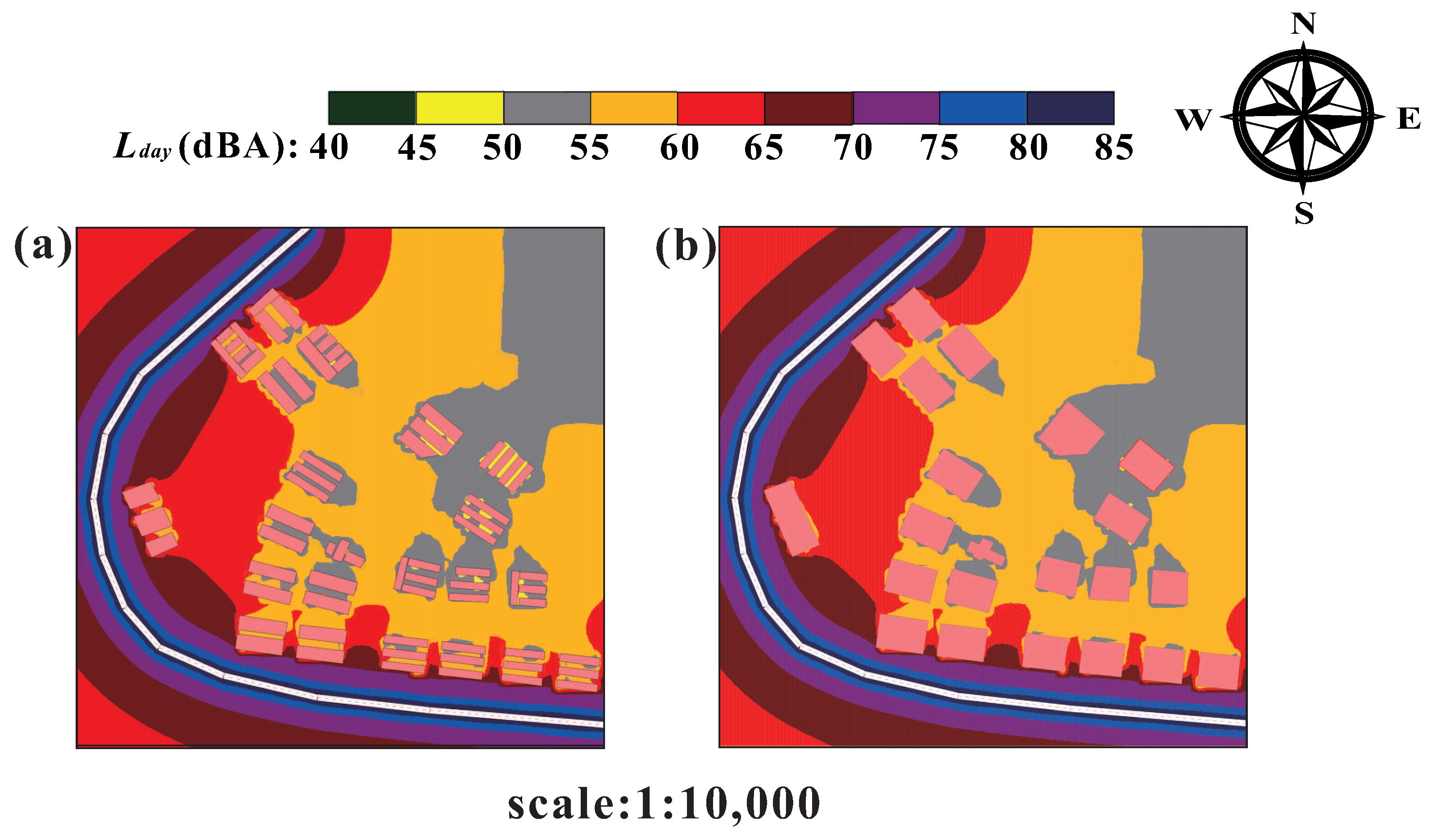





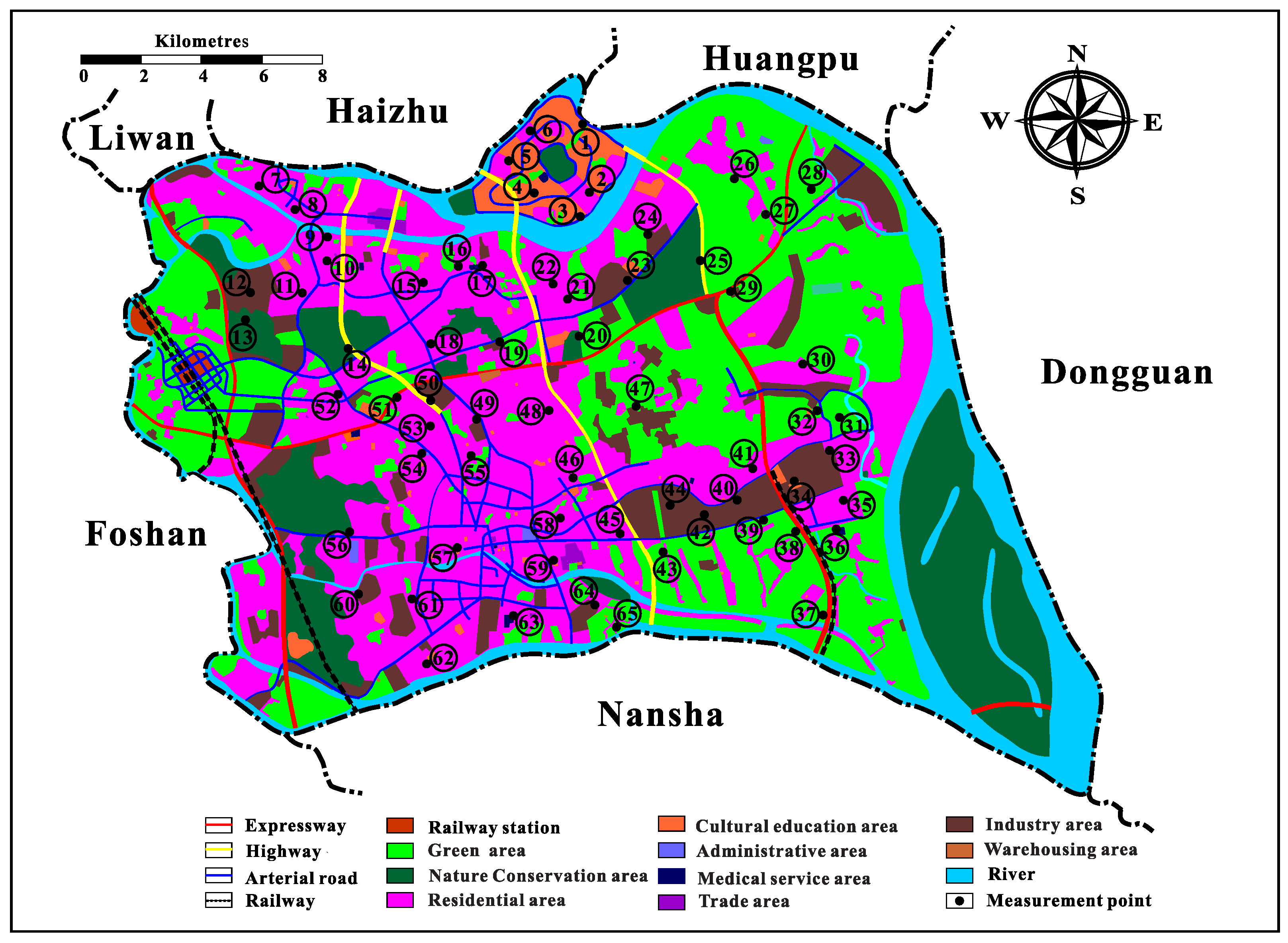

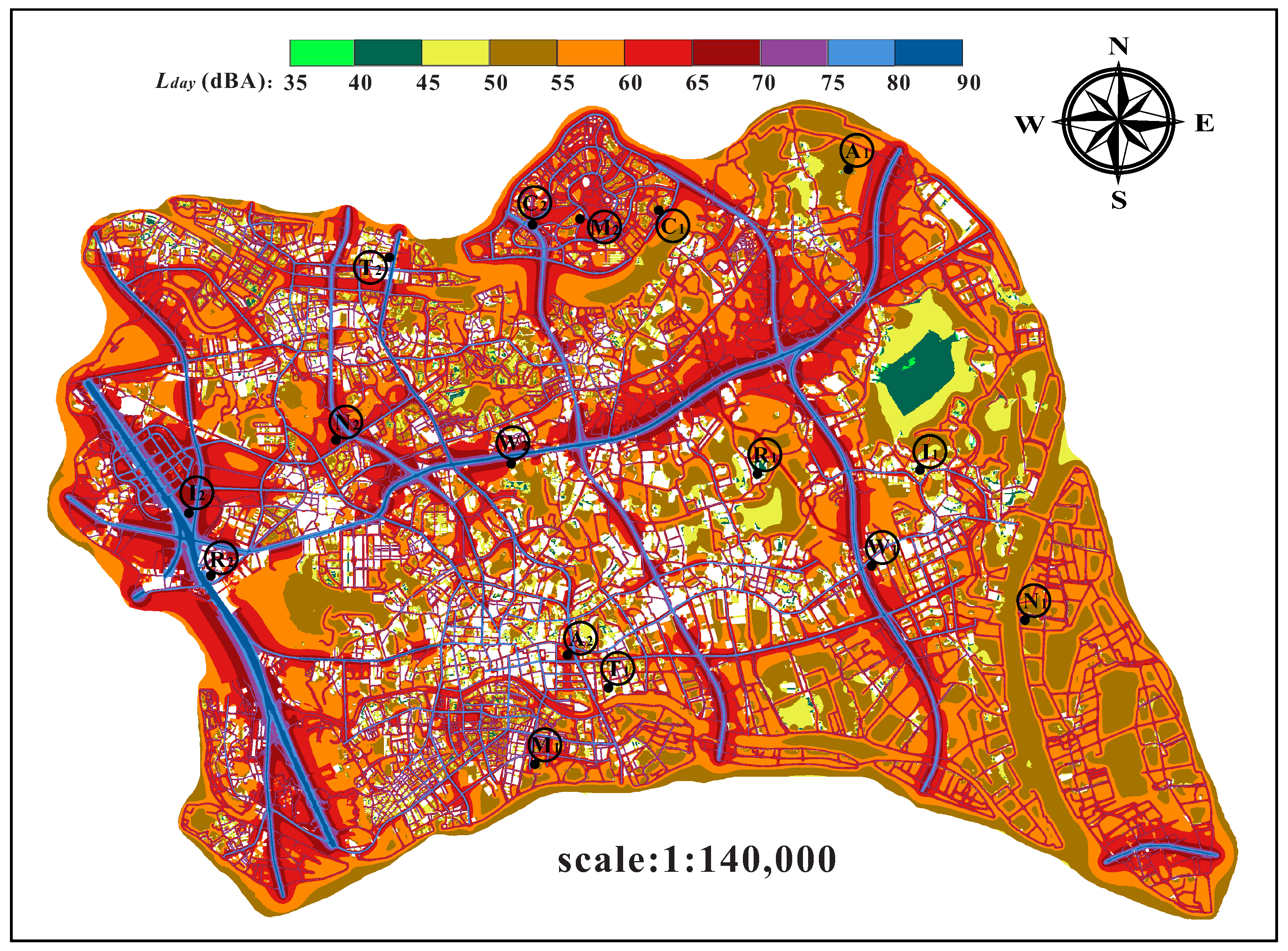


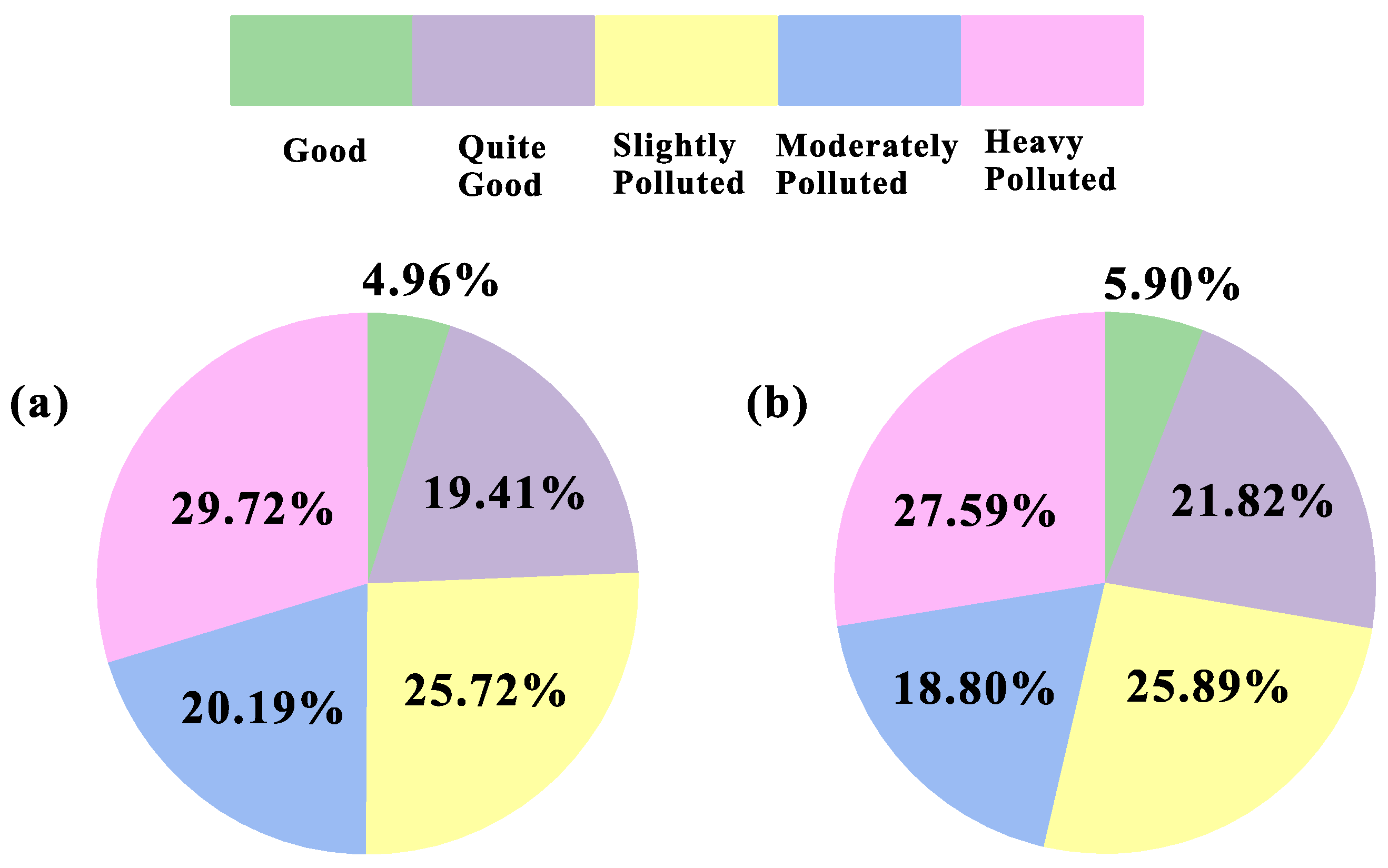

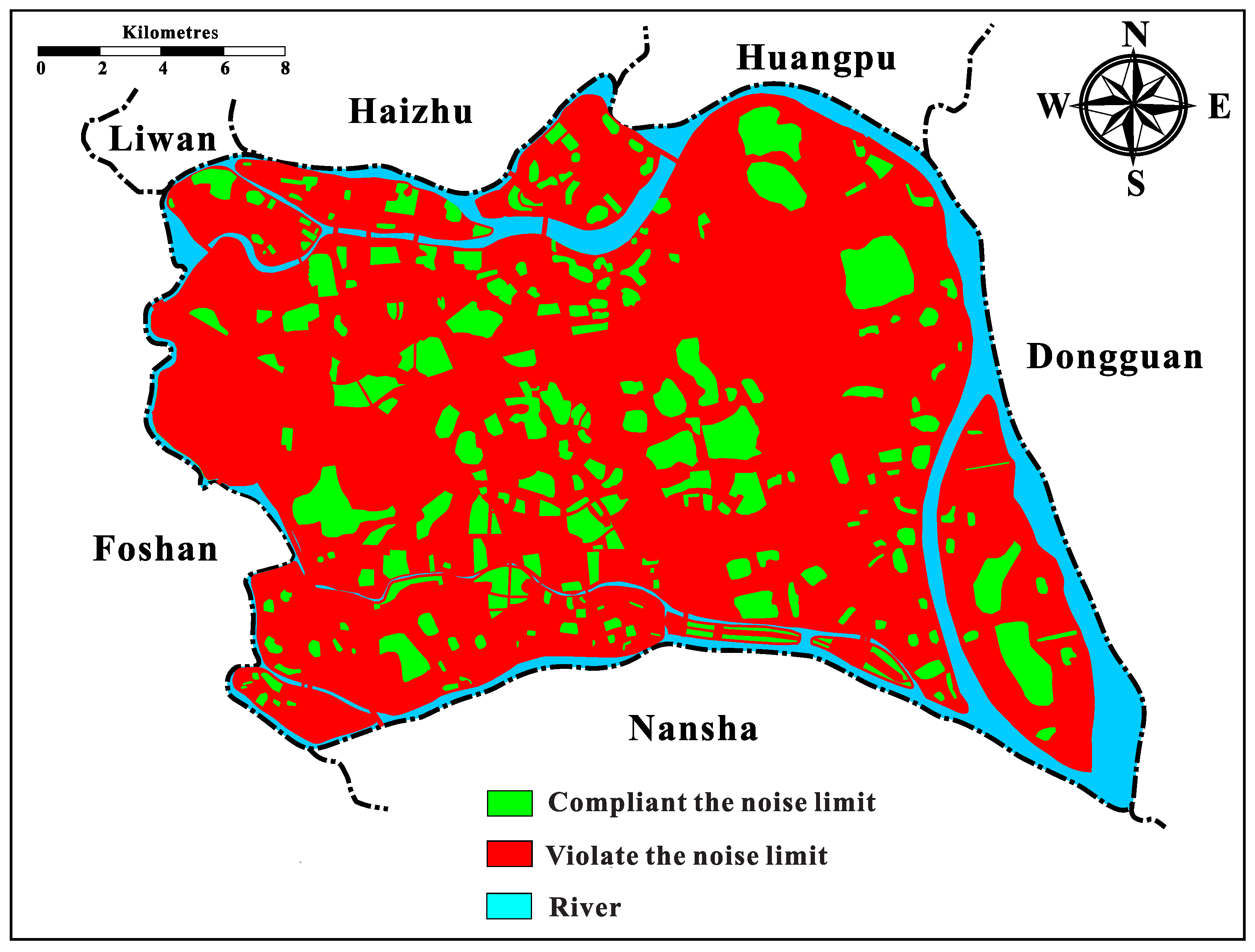

| Location | 4 m | 21 m | Measurement | Error | Error |
|---|---|---|---|---|---|
| 1 | 70.2 | 70.1 | 68.4 | 1.8 | 1.7 |
| 2 | 58.0 | 56.8 | 53.9 | 4.1 | 2.9 |
| 3 | 60.4 | 59.9 | 57.4 | 3.0 | 2.5 |
| 4 | 66.1 | 64.0 | 62.9 | 3.2 | 1.1 |
| 5 | 63.9 | 62.9 | 62.5 | 1.4 | 0.4 |
| 6 | 64.9 | 64.4 | 62.2 | 2.7 | 2.2 |
| Type | Number | Number | Speed (km/h) | Speed (km/h) |
|---|---|---|---|---|
| G-series high-speed train | 277 | 22 | 219 | 204 |
| D-series high-speed Train | 219 | 17 | 173 | 165 |
| Inter-city rail service | 108 | 12 | 124 | 123 |
| Timing | Number | Speed (km/h) |
|---|---|---|
| Day | 316 | 90 |
| Night | 37 | 90 |
| Type | Number of Points | Distance (km) | Number of Roads |
|---|---|---|---|
| Expressway | 4 | 10 | 2 |
| Highway | 3 | 10 | 2 |
| Arterial road | 14 | 5 | 9 |
| Sub-arterial road | 23 | 2 | 24 |
| Access road | 21 | 1 | 21 |
| Type | Speed (km/h) | Speed (km/h) |
|---|---|---|
| Car | 47 | 46 |
| Truck | 45 | 42 |
| Type | Traffic Flow (n/h) | Traffic Flow (n/h) |
|---|---|---|
| Small car | 756 (81.81%) | 258 (72.88%) |
| Mid-size car | 42 (4.55%) | 0 (0%) |
| Large car | 126 (13.64%) | 96 (27.12%) |
| Road/Railway | Average Height (m) |
|---|---|
| Guangzhou-Taishan Expressway | 15.6 |
| Guangzhou-Macao Expressway | 13.7 |
| Guangzhou-Longchuan Expressway | 12.2 |
| Dongsha-Xinlian Expressway | 8.5 |
| Nansha Harbour Highway | 25.1 |
| Xinguang Highway | 17.5 |
| Xinhua Highway | 23.3 |
| South China Highway | 12.6 |
| Guangzhou Metro Line 4 (ground section) | 8.5 |
| High-speed railway | 25.7 |
| Class | Coverage | Area (km) | Limit (dBA) | Limit (dBA) |
|---|---|---|---|---|
| 1 | Nature conservation area, cultural education area, administrative area and medical service area | 69.5 | 55 | 45 |
| 2 | Residential area and Trade area | 331.5 | 60 | 50 |
| 3 | Warehouse & logistics area and industry area | 49.1 | 65 | 55 |
| 4a, 4b | Areas on both side of traffic artery | 79.8 | 70 | 55, 60 |
| Noise indicator | Minimum (dBA) | Maximum (dBA) |
|---|---|---|
| 39.9 | 85.3 | |
| 39.4 | 78.1 | |
| 42.5 | 89.1 |
| Functional Area | ||||
|---|---|---|---|---|
| Nature conservation area | 42.8 | 42.1 | 63.2 | 63.1 |
| Residential area | 43.4 | 43.1 | 70.5 | 69.1 |
| Cultural education area | 44.7 | 44.2 | 68.8 | 68.5 |
| Administrative area | 53.0 | 52.6 | 63.2 | 62.6 |
| Medical service area | 48.7 | 48.3 | 63.4 | 62.5 |
| Trade area | 45.9 | 44.1 | 67.0 | 66.3 |
| Industry area | 44.8 | 43.8 | 71.0 | 70.6 |
| Warehousing area | 54.3 | 54.5 | 68.4 | 67.8 |
| Class | Day (km) | Night (km) |
|---|---|---|
| 1 | 49.0 (70.50%) | 4.7 (6.76%) |
| 2 | 215.9 (65.13%) | 64.9 (19.58%) |
| 3 | 34.9 (71.08%) | 12.0 (24.44%) |
| 4 | 26.7 (33.46%) | 5.7 (7.14%) |
| Total | 326.5 (61.62%) | 87.2 (16.46%) |
| Type | Number of Measurement Point | E | E | E |
|---|---|---|---|---|
| Expressway | 4 | 2.0 | 2.2 | 2.1 |
| Highway | 3 | 1.1 | 1.4 | 1.3 |
| Arterial road | 14 | 1.0 | 0.9 | 0.9 |
| Sub-arterial road | 23 | 1.1 | 1.5 | 1.3 |
| Access road | 21 | 1.6 | 2.3 | 1.9 |
| Overall | 65 | 1.3 | 1.7 | 1.5 |
| Timing | Type | Average | Minimum | Maximum |
|---|---|---|---|---|
| Day | Small car | 712 ± 913 | 37 | 4050 |
| Mid-size car | 39 ± 53 | 0 | 216 | |
| Large car | 48 ± 74 | 0 | 378 | |
| Night | Small car | 682 ± 912 | 36 | 3930 |
| Mid-size car | 37 ± 56 | 0 | 216 | |
| Large car | 45 ± 69 | 0 | 342 |
Publisher’s Note: MDPI stays neutral with regard to jurisdictional claims in published maps and institutional affiliations. |
© 2022 by the authors. Licensee MDPI, Basel, Switzerland. This article is an open access article distributed under the terms and conditions of the Creative Commons Attribution (CC BY) license (https://creativecommons.org/licenses/by/4.0/).
Share and Cite
Lee, H.M.; Luo, W.; Xie, J.; Lee, H.P. Urban Traffic Noise Mapping Using Building Simplification in the Panyu District of Guangzhou City, China. Sustainability 2022, 14, 4465. https://doi.org/10.3390/su14084465
Lee HM, Luo W, Xie J, Lee HP. Urban Traffic Noise Mapping Using Building Simplification in the Panyu District of Guangzhou City, China. Sustainability. 2022; 14(8):4465. https://doi.org/10.3390/su14084465
Chicago/Turabian StyleLee, Hsiao Mun, Wensheng Luo, Jinlong Xie, and Heow Pueh Lee. 2022. "Urban Traffic Noise Mapping Using Building Simplification in the Panyu District of Guangzhou City, China" Sustainability 14, no. 8: 4465. https://doi.org/10.3390/su14084465
APA StyleLee, H. M., Luo, W., Xie, J., & Lee, H. P. (2022). Urban Traffic Noise Mapping Using Building Simplification in the Panyu District of Guangzhou City, China. Sustainability, 14(8), 4465. https://doi.org/10.3390/su14084465








